Combining Hydrological Modeling and Regional Climate Projections to Assess the Climate Change Impact on the Water Resources of Dam Reservoirs
Abstract
:1. Introduction
2. Materials and Methods
2.1. Study Area
2.2. Climate Data
2.2.1. Historical Data
2.2.2. Future Climate Projections
2.3. Hydrological Data
2.4. Hydrological Modeling
2.4.1. The Hydrologic Modeling System (HEC-HMS)
2.4.2. Model Setup
2.4.3. Model Calibration
3. Results
3.1. Climate Analysis
3.1.1. Historical Climate
3.1.2. Future Climate Projections
3.2. Hydrological Analysis
3.2.1. Historical Period
3.2.2. Future Scenarios
4. Discussion and Conclusions
Author Contributions
Funding
Data Availability Statement
Acknowledgments
Conflicts of Interest
References
- Intergovernmental Panel on Climate Change. Climate Change 2021—The Physical Science Basis: Working Group I Contribution to the Sixth Assessment Report of the Intergovernmental Panel on Climate Change, 1st ed.; Cambridge University Press: Cambridge, UK, 2023; ISBN 978-1-00-915789-6. [Google Scholar]
- ICOLD. Global Climate Change, Dams, Reservoirs and Related Water Resources; Bulletin 169; International Commission on Large Dams (ICOLD): Paris, France, 2016. [Google Scholar]
- Italian Ministry of Environment and Energy Security. National Adaptation Strategy to Climate Change; Italian Ministry of Environment and Energy Security: Roma, Italy, 2015.
- Arora, V.K.; Boer, G.J. Effects of Simulated Climate Change on the Hydrology of Major River Basins. J. Geophys. Res. 2001, 106, 3335–3348. [Google Scholar] [CrossRef]
- Hakala, K.; Addor, N.; Teutschbein, C.; Vis, M.; Dakhlaoui, H.; Seibert, J. Hydrological Modeling of Climate Change Impacts. In Encyclopedia of Water; Maurice, P., Ed.; Wiley: Hoboken, NJ, USA, 2019; pp. 1–20. ISBN 978-1-119-30075-5. [Google Scholar]
- Banda, V.D.; Dzwairo, R.B.; Singh, S.K.; Kanyerere, T. Hydrological Modelling and Climate Adaptation under Changing Climate: A Review with a Focus in Sub-Saharan Africa. Water 2022, 14, 4031. [Google Scholar] [CrossRef]
- Leavesley, G.H. Modeling the Effects of Climate Change on Water Resources—A Review. Clim. Chang. 1994, 28, 159–177. [Google Scholar] [CrossRef]
- Lana-Renault, N.; Morán-Tejeda, E.; Moreno de las Heras, M.; Lorenzo-Lacruz, J.; López-Moreno, N. Land-Use Change and Impacts. In Water Resources in the Mediterranean Region; Elsevier: Amsterdam, The Netherlands, 2020; pp. 257–296. ISBN 978-0-12-818086-0. [Google Scholar]
- Pachauri, R.K.; Meyer, L.; Hallegatte France, S.; Bank, W.; Hegerl, G.; Brinkman, S.; van Kesteren, L.; Leprince-Ringuet, N.; van Boxmeer, F. AR5 Synthesis Report: Climate Change 2014; IPCC: Geneva, Switzerland, 2014. [Google Scholar]
- Calvin, K.; Dasgupta, D.; Krinner, G.; Mukherji, A.; Thorne, P.W.; Trisos, C.; Romero, J.; Aldunce, P.; Barrett, K.; Blanco, G.; et al. IPCC, 2023: Climate Change 2023: Synthesis Report. Contribution of Working Groups I, II and III to the Sixth Assessment Report of the Intergovernmental Panel on Climate Change; Core Writing Team, Lee, H., Romero, J., Eds.; Intergovernmental Panel on Climate Change (IPCC): Geneva, Switzerland, 2023. [Google Scholar]
- Teutschbein, C.; Seibert, J. Bias Correction of Regional Climate Model Simulations for Hydrological Climate-Change Impact Studies: Review and Evaluation of Different Methods. J. Hydrol. 2012, 456–457, 12–29. [Google Scholar] [CrossRef]
- Teutschbein, C.; Seibert, J. Regional Climate Models for Hydrological Impact Studies at the Catchment Scale: A Review of Recent Modeling Strategies: Regional Climate Models for Hydrological Impact Studies. Geogr. Compass 2010, 4, 834–860. [Google Scholar] [CrossRef]
- D’Oria, M.; Ferraresi, M.; Tanda, M.G. Historical Trends and High-Resolution Future Climate Projections in Northern Tuscany (Italy). J. Hydrol. 2017, 555, 708–723. [Google Scholar] [CrossRef]
- D’Oria, M.; Tanda, M.; Todaro, V. Assessment of Local Climate Change: Historical Trends and RCM Multi-Model Projections Over the Salento Area (Italy). Water 2018, 10, 978. [Google Scholar] [CrossRef]
- Alfio, M.R.; Pisinaras, V.; Panagopoulos, A.; Balacco, G. A Comprehensive Assessment of RCP4.5 Projections and Bias-Correction Techniques in a Complex Coastal Karstic Aquifer in the Mediterranean. Front. Earth Sci. 2023, 11, 1231296. [Google Scholar] [CrossRef]
- Parker, W.S. Ensemble Modeling, Uncertainty and Robust Predictions. Wiley Interdiscip. Rev. Clim. Chang. 2013, 4, 213–223. [Google Scholar] [CrossRef]
- Velázquez, J.A.; Schmid, J.; Ricard, S.; Muerth, M.J.; Gauvin St-Denis, B.; Minville, M.; Chaumont, D.; Caya, D.; Ludwig, R.; Turcotte, R. An Ensemble Approach to Assess Hydrological Models’ Contribution to Uncertainties in the Analysis of Climate Change Impact on Water Resources. Hydrol. Earth Syst. Sci. 2013, 17, 565–578. [Google Scholar] [CrossRef]
- Ravazzani, G.; Barbero, S.; Salandin, A.; Senatore, A.; Mancini, M. An Integrated Hydrological Model for Assessing Climate Change Impacts on Water Resources of the Upper Po River Basin. Water Resour. Manag. 2015, 29, 1193–1215. [Google Scholar] [CrossRef]
- Ben Nsir, S.; Jomaa, S.; Yıldırım, Ü.; Zhou, X.; D’Oria, M.; Rode, M.; Khlifi, S. Assessment of Climate Change Impact on Discharge of the Lakhmass Catchment (Northwest Tunisia). Water 2022, 14, 2242. [Google Scholar] [CrossRef]
- Perra, E.; Piras, M.; Deidda, R.; Paniconi, C.; Mascaro, G.; Vivoni, E.R.; Cau, P.; Marras, P.A.; Ludwig, R.; Meyer, S. Multimodel Assessment of Climate Change-Induced Hydrologic Impacts for a Mediterranean Catchment. Hydrol. Earth Syst. Sci. 2018, 22, 4125–4143. [Google Scholar] [CrossRef]
- Vezzoli, R.; Mercogliano, P.; Pecora, S.; Zollo, A.L.; Cacciamani, C. Hydrological Simulation of Po River (North Italy) Discharge under Climate Change Scenarios Using the RCM COSMO-CLM. Sci. Total Environ. 2015, 521–522, 346–358. [Google Scholar] [CrossRef] [PubMed]
- Majone, B.; Bovolo, C.I.; Bellin, A.; Blenkinsop, S.; Fowler, H.J. Modeling the Impacts of Future Climate Change on Water Resources for the Gállego River Basin (Spain): Climate Change Impacts on Water Resources. Water Resour. Res. 2012, 48, W01512. [Google Scholar] [CrossRef]
- Karam, S.; Zango, B.-S.; Seidou, O.; Perera, D.; Nagabhatla, N.; Tshimanga, R.M. Impacts of Climate Change on Hydrological Regimes in the Congo River Basin. Sustainability 2023, 15, 6066. [Google Scholar] [CrossRef]
- Versini, P.-A.; Pouget, L.; McEnnis, S.; Custodio, E.; Escaler, I. Climate Change Impact on Water Resources Availability: Case Study of the Llobregat River Basin (Spain). Hydrol. Sci. J. 2016, 61, 2496–2508. [Google Scholar] [CrossRef]
- Emami, F.; Koch, M. Modeling the Impact of Climate Change on Water Availability in the Zarrine River Basin and Inflow to the Boukan Dam, Iran. Climate 2019, 7, 51. [Google Scholar] [CrossRef]
- Teklay, A.; Dile, Y.T.; Asfaw, D.H.; Bayabil, H.K.; Sisay, K.; Ayalew, A. Modeling the Impact of Climate Change on Hydrological Responses in the Lake Tana Basin, Ethiopia. Dyn. Atmos. Oceans 2022, 97, 101278. [Google Scholar] [CrossRef]
- Babur, M.; Babel, M.; Shrestha, S.; Kawasaki, A.; Tripathi, N. Assessment of Climate Change Impact on Reservoir Inflows Using Multi Climate-Models under RCPs—The Case of Mangla Dam in Pakistan. Water 2016, 8, 389. [Google Scholar] [CrossRef]
- D’Oria, M.; Ferraresi, M.; Tanda, M.G. Quantifying the Impacts of Climate Change on Water Resources in Northern Tuscany, Italy, Using High-Resolution Regional Projections. Hydrol. Process. 2019, 33, 978–993. [Google Scholar] [CrossRef]
- Abdulahi, S.D.; Abate, B.; Harka, A.E.; Husen, S.B. Response of Climate Change Impact on Streamflow: The Case of the Upper Awash Sub-Basin, Ethiopia. J. Water Clim. Chang. 2022, 13, 607–628. [Google Scholar] [CrossRef]
- Dau, Q.V.; Kuntiyawichai, K.; Adeloye, A.J. Future Changes in Water Availability Due to Climate Change Projections for Huong Basin, Vietnam. Environ. Process. 2021, 8, 77–98. [Google Scholar] [CrossRef]
- IPCC (Ed.) Emissions Scenarios: Summary for Policy Makers; a Special Report of IPCC Working Group III of the Intergovernmental Panel on Climate Change; IPCC special report; Intergovernmental Panel on Climate Change: Geneva, Switzerland, 2000; ISBN 978-92-9169-113-5. [Google Scholar]
- Jacob, D.; Petersen, J.; Eggert, B.; Alias, A.; Christensen, O.B.; Bouwer, L.M.; Braun, A.; Colette, A.; Déqué, M.; Georgievski, G.; et al. EURO-CORDEX: New High-Resolution Climate Change Projections for European Impact Research. Reg. Environ. Chang. 2014, 14, 563–578. [Google Scholar] [CrossRef]
- United States Department of Agriculture. Soil Survey Manual; Agriculture Handbook No. 18; United States Department of Agriculture: Washington, DC, USA, 2017.
- Allen, R.G.; Pereira, L.S.; Raes, D.; Smith, M. FAO Irrigation and Drainage Paper No. 56.; Food and Agriculture Organization of the United Nations: Rome, Italy, 1998; Volume 56, p. e156. [Google Scholar]
- Fagandini, C.; Todaro, V.; Tanda, M.G.; Pereira, J.L.; Azevedo, L.; Zanini, A. Missing Rainfall Daily Data: A Comparison Among Gap-Filling Approaches. Math. Geosci. 2023, 1–27. [Google Scholar] [CrossRef]
- Thornthwaite, C.W. An Approach toward a Rational Classification of Climate. Geogr. Rev. 1948, 38, 55. [Google Scholar] [CrossRef]
- Mann, H.B. Nonparametric Tests Against Trend. Econometrica 1945, 13, 245. [Google Scholar] [CrossRef]
- Kendall, M.G. Rank Correlation Methods, 4th ed.; Griffin: London, UK, 1970; ISBN 978-0-85264-199-6. [Google Scholar]
- Hamed, K.H.; Ramachandra Rao, A. A Modified Mann-Kendall Trend Test for Autocorrelated Data. J. Hydrol. 1998, 204, 182–196. [Google Scholar] [CrossRef]
- Sen, P.K. Estimates of the Regression Coefficient Based on Kendall’s Tau. J. Am. Stat. Assoc. 1968, 63, 1379–1389. [Google Scholar] [CrossRef]
- Secci, D.; Tanda, M.G.; D’Oria, M.; Todaro, V.; Fagandini, C. Impacts of Climate Change on Groundwater Droughts by Means of Standardized Indices and Regional Climate Models. J. Hydrol. 2021, 603, 127154. [Google Scholar] [CrossRef]
- Teng, J.; Potter, N.J.; Chiew, F.H.S.; Zhang, L.; Wang, B.; Vaze, J.; Evans, J.P. How Does Bias Correction of Regional Climate Model Precipitation Affect Modelled Runoff? Hydrol. Earth Syst. Sci. 2015, 19, 711–728. [Google Scholar] [CrossRef]
- Todaro, V.; D’Oria, M.; Secci, D.; Zanini, A.; Tanda, M.G. Climate Change over the Mediterranean Region: Local Temperature and Precipitation Variations at Five Pilot Sites. Water 2022, 14, 2499. [Google Scholar] [CrossRef]
- Zoppou, C. Reverse Routing of Flood Hydrographs Using Level Pool Routing. J. Hydrol. Eng. 1999, 4, 184–188. [Google Scholar] [CrossRef]
- D’Oria, M.; Mignosa, P.; Tanda, M.G. Reverse Level Pool Routing: Comparison between a Deterministic and a Stochastic Approach. J. Hydrol. 2012, 470–471, 28–35. [Google Scholar] [CrossRef]
- Scharffenberg, W.A. Hydrologic Modeling System HEC-HMS: User’s Manual; U.S. Army Corps of Engineers: Hydrologic Engineering Center, HEC: Davis, CA, USA, 2013. [Google Scholar]
- Feldman, A.D. Hydrologic Modeling System HEC-HMS: Technical Reference Manual; U.S. Army Corps of Engineers: Hydrologic Engineering Center, HEC: Davis, CA, USA, 2000. [Google Scholar]
- Sahu, M.K.; Shwetha, H.R.; Dwarakish, G.S. State-of-the-Art Hydrological Models and Application of the HEC-HMS Model: A Review. Model. Earth Syst. Environ. 2023, 9, 3029–3051. [Google Scholar] [CrossRef]
- Fleming, M.; Neary, V. Continuous Hydrologic Modeling Study with the Hydrologic Modeling System. J. Hydrol. Eng. 2004, 9, 175–183. [Google Scholar] [CrossRef]
- Bennett, T. Development and Application of a Continuous Soil Moisture Accounting Algorithm for the Hydrologic Engineering Center Hydrologic Modeling System (HEC-HMS). Master’s Thesis, Department of Civil and Environmental Engineering, University of California, Davis, CA, USA, 1998. [Google Scholar]
- Bennett, T.H.; Peters, J.C. Continuous Soil Moisture Accounting in the Hydrologic Engineering Center Hydrologic Modeling System (HEC-HMS). In Proceedings of the Building Partnerships, Minneapolis, MN, USA, 11 September 2000; American Society of Civil Engineers: Reston, VA, USA; pp. 1–10. [Google Scholar]
- Water Environment Federation; American Society of Civil Engineers. Design and Construction of Urban Stormwater Management Systems, 77th ed.; American Society of Civil Engineers and Water Environment Federation: Reston, VA, USA, 1992; ISBN 978-0-87262-855-7. [Google Scholar]
- FAO, Soil Resources, Management and Conservation Service (Ed.) Soil Survey Investigations for Irrigation; FAO Soils Bulletin Report; FAO Soils Bulletin: Rome, Italy, 1986; ISBN 978-92-5-100756-3. [Google Scholar]
- Allen, R.G.; Food and Agriculture Organization of the United Nations (Eds.) Crop Evapotranspiration: Guidelines for Computing Crop Water Requirements; FAO irrigation and drainage paper; Food and Agriculture Organization of the United Nations: Rome, Italy, 1998; ISBN 978-92-5-104219-9. [Google Scholar]
- Rawls, W.J.; Brakensiek, D.L.; Saxtonn, K.E. Estimation of Soil Water Properties. Trans. ASAE 1982, 25, 1316–1320. [Google Scholar] [CrossRef]
- Kirpich, Z.P. Time of Concentration of Small Agricultural Watersheds. Civil. Eng. 1940, 10, 362. [Google Scholar]
- Russell, S.O.; Sunnell, G.J.; Kenning, B.F.I. Estimating Design Flows for Urban Drainage. J. Hydraul. Eng. 1979, 105, 43–52. [Google Scholar] [CrossRef]
- Coon, W.F. Estimation of Roughness Coefficients for Natural Stream Channels with Vegetated Banks; U.S. Geological Survey water-supply paper; U.S. Geological Survey: Denver, CO, USA, 1998; ISBN 978-0-607-88701-3. [Google Scholar]
- Doherty, J.E. PEST, Model-Independent Parameter Estimation, User Manual Part I: PEST, SENSAN and Global Optimisers; Watermark Numerical Computing: Brisbane, Australia, 2018. [Google Scholar]
- Kim, S.M.; Benham, B.L.; Brannan, K.M.; Zeckoski, R.W.; Doherty, J. Comparison of Hydrologic Calibration of HSPF Using Automatic and Manual Methods. Water Resour. Res. 2007, 43, 2006WR004883. [Google Scholar] [CrossRef]
- Doherty, J.E.; Hunt, R.J. Approaches to Highly Parameterized Inversion: Guide to Using PEST for Groundwater-Model Calibration; Scientific Investigations Report; U.S. Geological Survey: Reston, VA, USA, 2010.
- Doherty, J. Calibration and Uncertainty Analysis for Complex Environmental Models; Watermark Numerical Computing: Brisbane, Australia, 2015. [Google Scholar]
- Wheater, H.; Evans, E. Land Use, Water Management and Future Flood Risk. Land Use Policy 2009, 26, S251–S264. [Google Scholar] [CrossRef]
- Jha, M.K. Impacts of Landscape Changes on Water Resources. Water 2020, 12, 2244. [Google Scholar] [CrossRef]
- Samal, D.R.; Gedam, S. Assessing the Impacts of Land Use and Land Cover Change on Water Resources in the Upper Bhima River Basin, India. Environ. Chall. 2021, 5, 100251. [Google Scholar] [CrossRef]
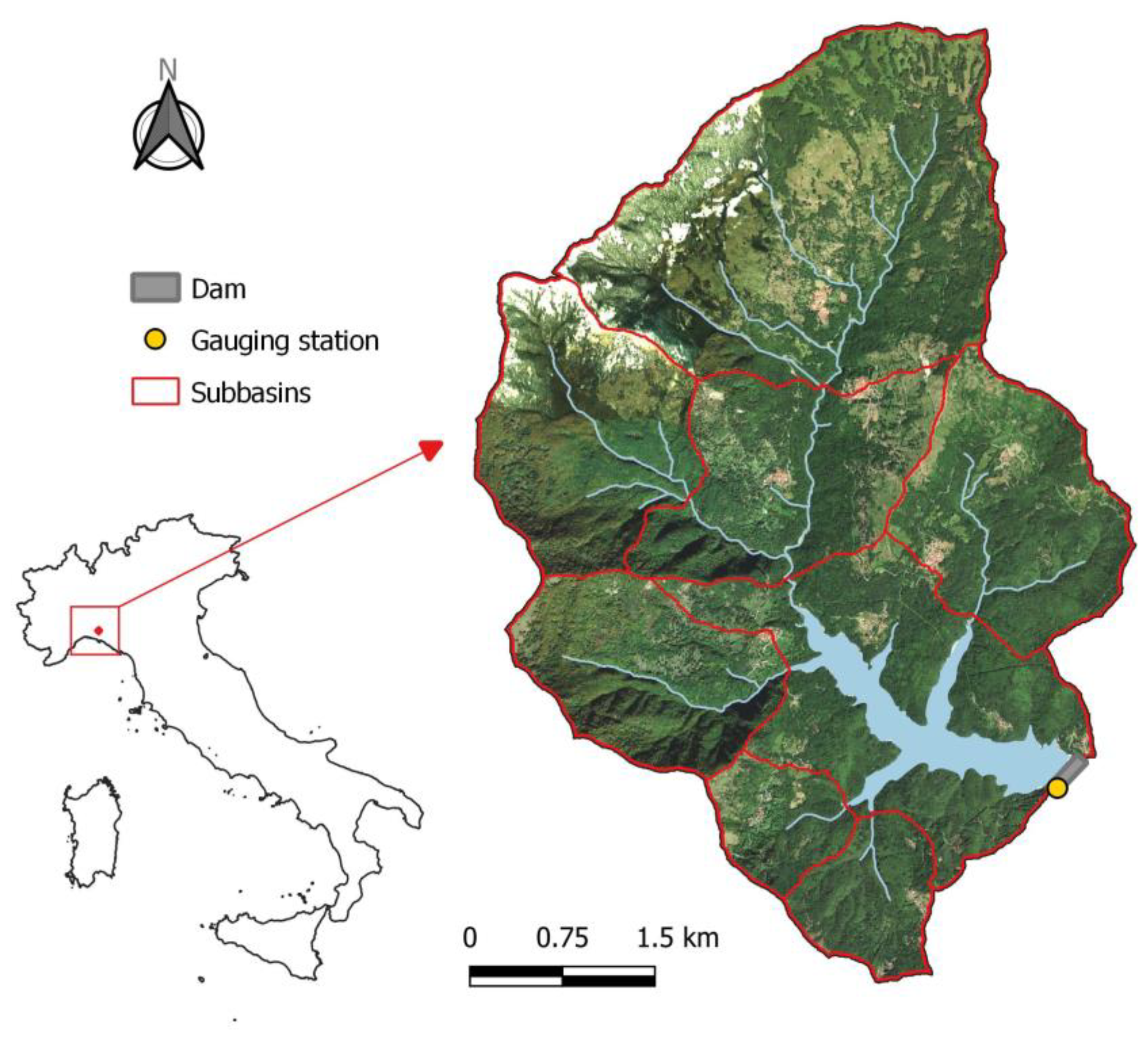
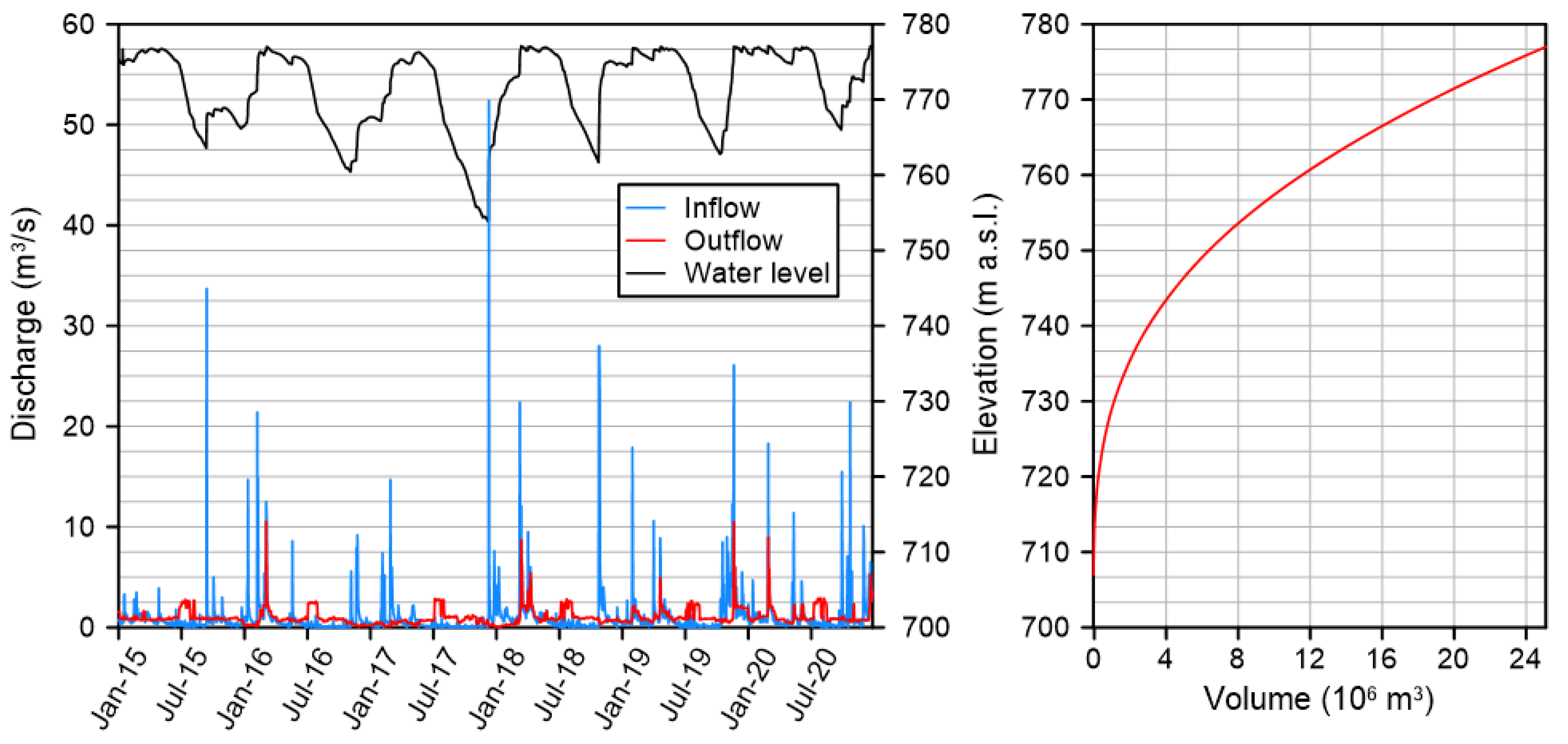

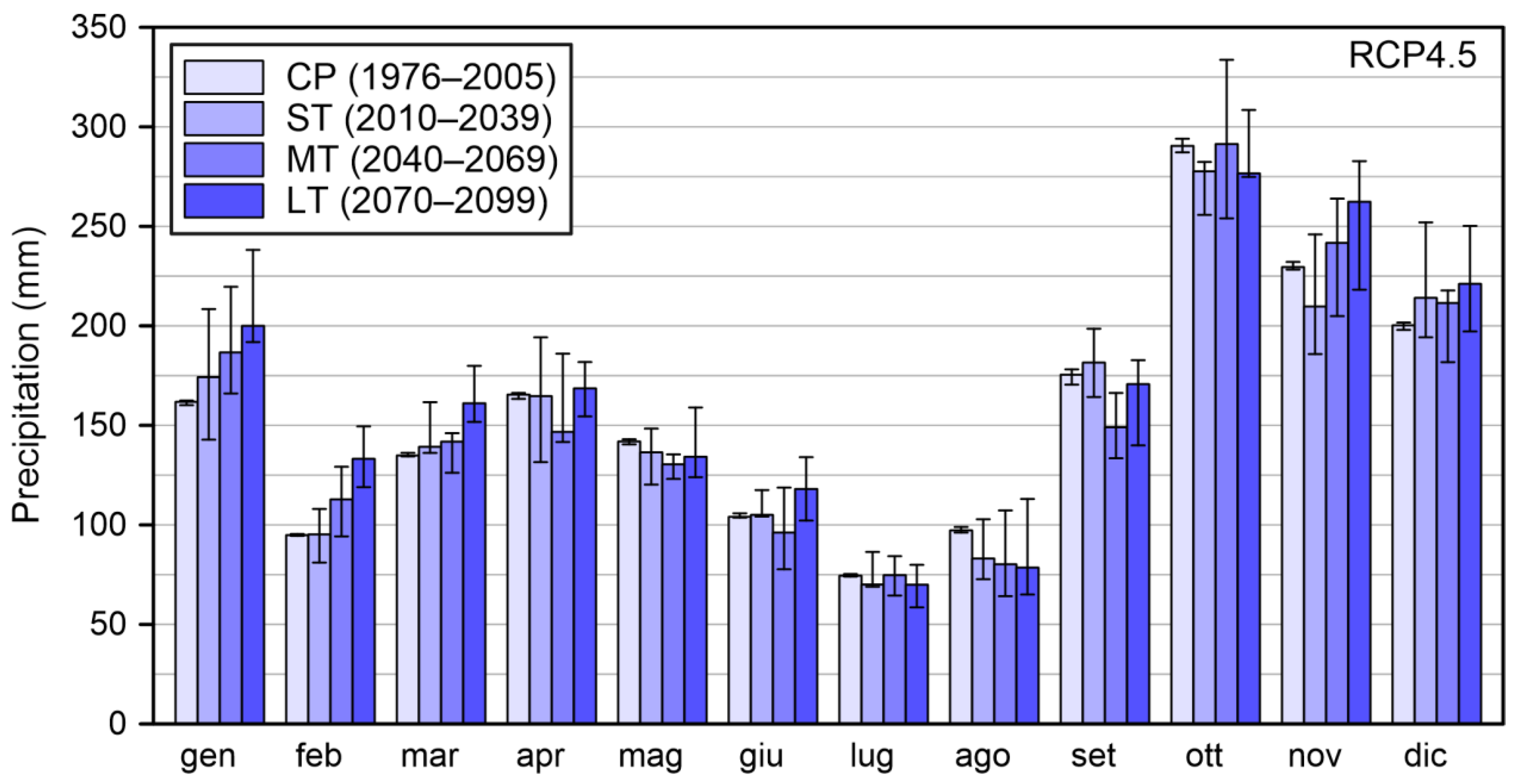


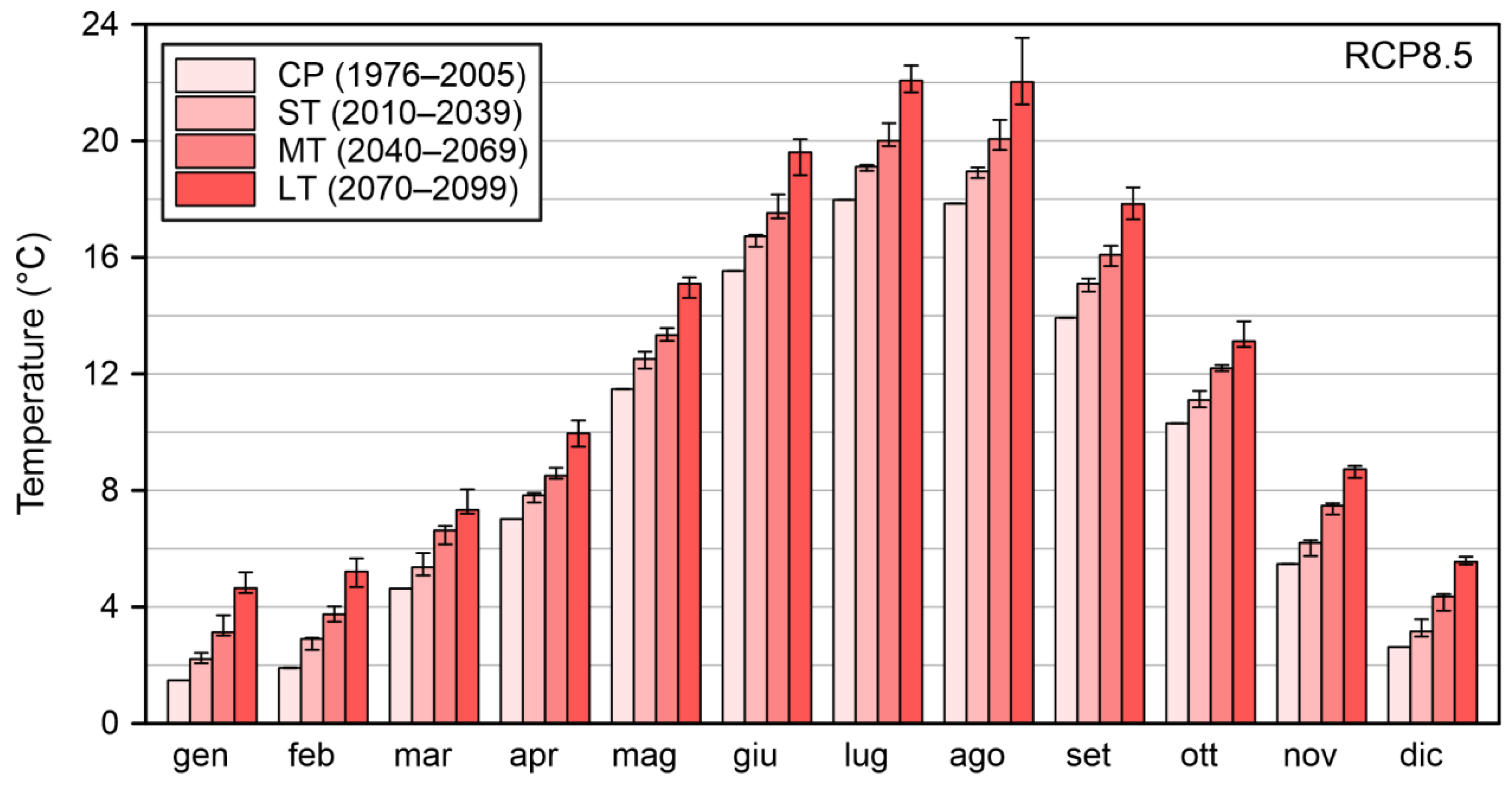
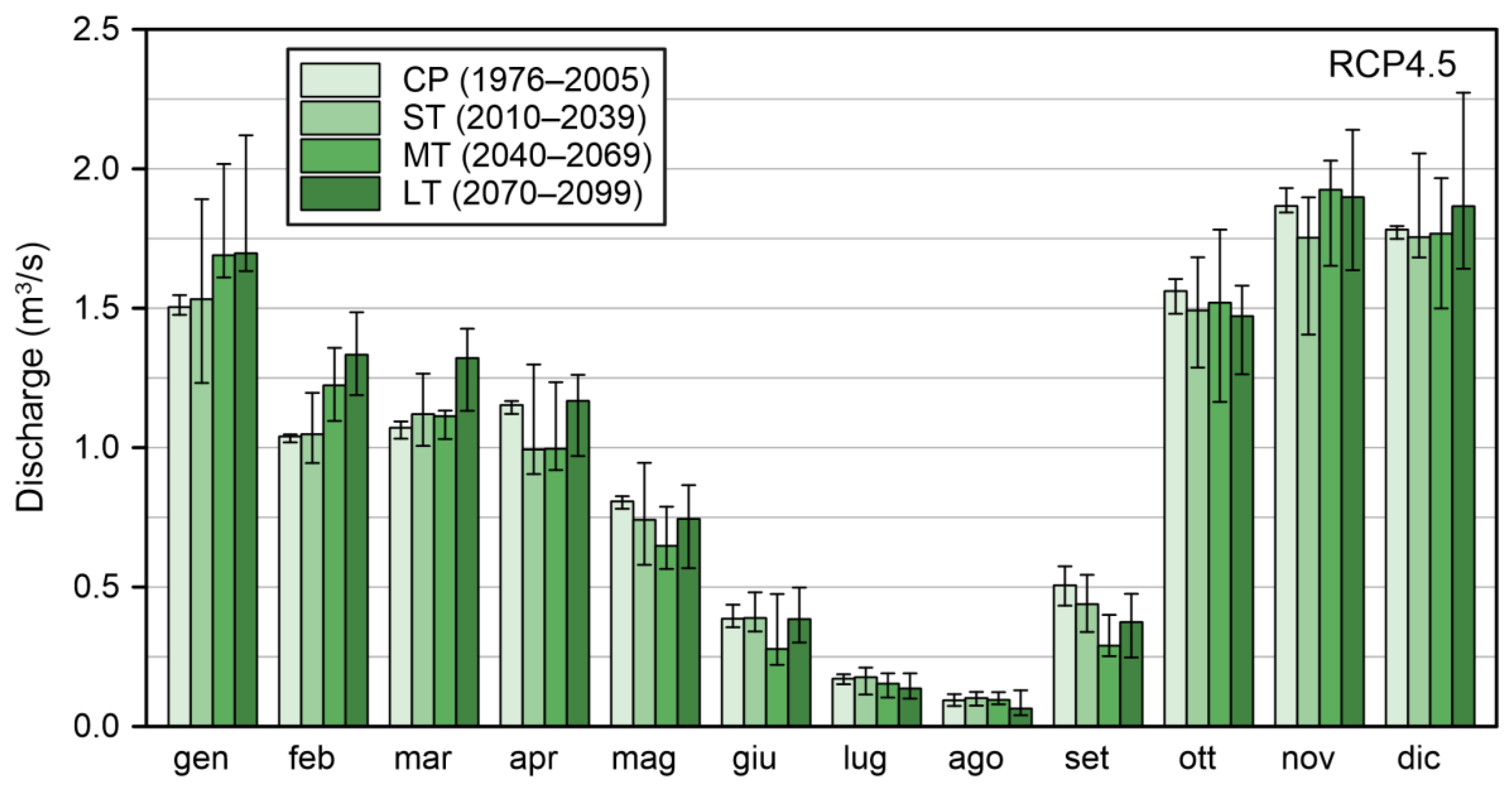


| GCM | RCM | |
|---|---|---|
| 1 | CNRM-CM5 | CCLM4-8-17 |
| 2 | “ | RCA4 |
| 3 | “ | RACMO22E |
| 4 | EC-EARTH | RACMO22E |
| 5 | “ | RCA4 |
| 6 | “ | CCLM4-8-17 |
| 7 | “ | HIRHAM5 |
| 8 | IPSL-CM5A-MR | WRF381P |
| 9 | “ | RCA4 |
| 10 | “ | WRF331F |
| 11 | MPI-ESM-LR | CCLM4-8-17 |
| 12 | “ | RCA4 |
| 13 | NorESM1-M | HIRHAM5 |
| Parameter | Units | Initial Estimate Criteria | Module |
|---|---|---|---|
| Maximum canopy storage | mm | Land cover [50,52] | Soil Moisture Accounting (SMA) |
| Maximum surface storage | mm | Land cover [50,52] | |
| Maximum infiltration rate * | mm/h | Soil type [53] | |
| Impervious surface area | % | Land cover | |
| Total soil storage * | mm | Soil type [54,55] | |
| Soil tension storage * | mm | Soil type [54,55] | |
| Soil percolation * | mm/h | Soil type (hydraulic conductivity) [49,55] | |
| Groundwater1 * and 2 * storage | mm | Flow–recession curves [49] | |
| Groundwater 1 * and 2 percolation | mm/h | Soil type (hydraulic conductivity) [49,55] | |
| Groundwater 1 * and 2 * coefficient | h | Flow–recession curves [49] | |
| Groundwater 1 and 2 fraction | - | Not needed using SMA | Baseflow—linear reservoir |
| Groundwater 1 and 2 storage coefficient | h | 12 h, the minimum for daily-scale simulations [46] | |
| Time of concentration | h | Kirpich formulation [56] | Clark unit hydrograph |
| Storage coefficient | h | Time of concentration and land cover [57] | |
| Length | m | DEM | Kinematic wave |
| Slope | m/m | DEM | |
| Manning’s coefficient | s/m1/3 | River bed material [58] | |
| Width | m | DEM |
| Metrics | Calibration Period | Validation Period |
|---|---|---|
| Volume Bias | −0.21% | 5.68% |
| Nash–Sutcliffe | 0.733 | 0.607 |
| RMSE | 17.31 | 11.04 |
| Precipitation | Temperature | |||
|---|---|---|---|---|
| Mean (mm) | Trend (mm/decade) | Mean (°C) | Trend (°C/decade) | |
| Jan | 157.1 | −1.5 | 1.48 | +0.39 |
| Feb | 91.7 | −11.2 | 1.91 | +0.29 |
| Mar | 130.4 | −28.7 | 4.63 | +0.67 |
| Apr | 161.1 | +9.6 | 7.02 | +0.64 * |
| May | 135.8 | +3.1 | 11.48 | +1.07 * |
| Jun | 98.9 | −6.2 | 15.54 | +0.76 * |
| Jul | 69.7 | +8.2 | 17.98 | +0.29 |
| Aug | 92.8 | −9.7 | 17.85 | +0.85 * |
| Sep | 165.6 | +10.2 | 13.92 | +0.41 |
| Oct | 285.9 | −9.3 | 10.30 | +0.61 * |
| Nov | 225.0 | +44.6 | 5.48 | +0.60 * |
| Dec | 196.0 | −7.8 | 2.62 | +0.23 |
| Year | 1810.1 | +73.4 | 9.18 | +0.63 * |
| RCP4.5 | RCP8.5 | ||||||
|---|---|---|---|---|---|---|---|
| CP | ST | MT | LT | ST | MT | LT | |
| Jan | 161.9 | +7.6% | +15.3% | +23.6% | +2.1% | +24.0% | +16.2% |
| Feb | 94.9 | +0.3% | +18.9% | +40.3% | +11.6% | +20.2% | +14.0% |
| Mar | 134.9 | +3.2% | +5.1% | +19.4% | +3.3% | +13.4% | +16.5% |
| Apr | 165.5 | −0.5% | −11.3% | +1.9% | −8.8% | −2.8% | −12.6% |
| May | 141.9 | −3.8% | −8.1% | −5.4% | +2.7% | −0.6% | −16.7% |
| Jun | 104.1 | +0.9% | −7.6% | +13.4% | −4.0% | +3.3% | −13.1% |
| Jul | 74.5 | −5.9% | +0.4% | −6.1% | +2.0% | −5.2% | −27.7% |
| Aug | 97.2 | −14.5% | −17.5% | −19.2% | −13.7% | −14.4% | +15.8% |
| Sep | 175.5 | +3.5% | −15.1% | −2.7% | −4.9% | −14.3% | −19.3% |
| Oct | 290.4 | −4.4% | +0.3% | −4.8% | −14.4% | +0.5% | −17.4% |
| Nov | 229.5 | −8.6% | +5.3% | +14.3% | +5.9% | +8.8% | +9.5% |
| Dec | 200.3 | +6.9% | +5.6% | +10.4% | −1.5% | +2.9% | +12.9% |
| Year | 1872.3 | +3.1% | +2.0% | +8.4% | +1.7% | +4.9% | −3.0% |
| RCP4.5 | RCP8.5 | ||||||
|---|---|---|---|---|---|---|---|
| CP | ST | MT | LT | ST | MT | LT | |
| Jan | 1.48 | +0.66 | +1.41 | +1.78 | +0.73 | +1.65 | +3.17 |
| Feb | 1.91 | +0.69 | +1.13 | +1.70 | +0.99 | +1.84 | +3.31 |
| Mar | 4.63 | +0.90 | +1.17 | +1.44 | +0.73 | +1.99 | +2.70 |
| Apr | 7.02 | +0.69 | +1.04 | +1.50 | +0.81 | +1.49 | +2.94 |
| May | 11.48 | +0.85 | +1.62 | +2.11 | +1.04 | +1.86 | +3.63 |
| Jun | 15.54 | +1.03 | +2.08 | +2.00 | +1.19 | +1.99 | +4.07 |
| Jul | 17.98 | +0.96 | +1.78 | +1.92 | +1.13 | +2.03 | +4.10 |
| Aug | 17.85 | +0.88 | +2.07 | +2.22 | +1.11 | +2.22 | +4.17 |
| Sep | 13.92 | +1.03 | +1.60 | +2.07 | +1.18 | +2.17 | +3.91 |
| Oct | 10.30 | +0.80 | +1.25 | +1.65 | +0.80 | +1.89 | +2.82 |
| Nov | 5.48 | +0.52 | +1.13 | +1.74 | +0.72 | +2.00 | +3.25 |
| Dec | 2.62 | +0.85 | +0.93 | +1.45 | +0.54 | +1.74 | +2.92 |
| Year | 9.18 | +0.80 | +1.43 | +1.79 | +0.96 | +1.83 | +3.32 |
| Jan | Feb | Mar | Apr | May | Jun | Jul | Aug | Sep | Oct | Nov | Dec | Year |
|---|---|---|---|---|---|---|---|---|---|---|---|---|
| 1.52 | 1.02 | 0.97 | 1.16 | 0.74 | 0.35 | 0.14 | 0.05 | 0.43 | 1.63 | 1.87 | 1.61 | 0.96 |
| RCP4.5 | RCP8.5 | ||||||
|---|---|---|---|---|---|---|---|
| CP | ST | MT | LT | ST | MT | LT | |
| Jan | 1.50 | +1.9% | +12.4% | +12.8% | −1.0% | +11.7% | +4.6% |
| Feb | 1.04 | +0.8% | +17.6% | +28.2% | +3.5% | +11.7% | +14.2% |
| Mar | 1.07 | +4.6% | +3.9% | +23.4% | +4.0% | +5.4% | +11.6% |
| Apr | 1.15 | −13.9% | −13.6% | +1.3% | −15.7% | −3.7% | −23.0% |
| May | 0.81 | −8.2% | −19.8% | −7.8% | −3.1% | −11.5% | −32.6% |
| Jun | 0.39 | +0.7% | −28.0% | −0.3% | +5.2% | +2.8% | −44.1% |
| Jul | 0.17 | +3.0% | −10.2% | −20.5% | −7.8% | −21.2% | −66.4% |
| Aug | 0.09 | +9.1% | +1.4% | −31.3% | +6.2% | −25.4% | −21.1% |
| Sep | 0.51 | −13.4% | −42.7% | −26.1% | −24.7% | −36.7% | −40.1% |
| Oct | 1.56 | −4.4% | −2.7% | −5.7% | −28.4% | −10.2% | −32.0% |
| Nov | 1.87 | −6.1% | +3.1% | +1.7% | +1.2% | +1.6% | −4.5% |
| Dec | 1.78 | −1.6% | −0.8% | +4.7% | −5.7% | −0.5% | −0.9% |
| Year | 1.00 | +3.0% | −0.6% | +7.4% | −2.4% | +3.0% | −6.0% |
| RCP4.5 | RCP8.5 | ||||||
|---|---|---|---|---|---|---|---|
| CP | ST | MT | LT | ST | MT | LT | |
| Qwet | 1.01 | 0.96 | 0.96 | 0.98 | 0.95 | 0.97 | 0.83 |
| Qmid | 0.37 | 0.34 | 0.32 | 0.33 | 0.32 | 0.33 | 0.26 |
| Qdry | 0.10 | 0.09 | 0.07 | 0.08 | 0.08 | 0.08 | 0.06 |
Disclaimer/Publisher’s Note: The statements, opinions and data contained in all publications are solely those of the individual author(s) and contributor(s) and not of MDPI and/or the editor(s). MDPI and/or the editor(s) disclaim responsibility for any injury to people or property resulting from any ideas, methods, instructions or products referred to in the content. |
© 2023 by the authors. Licensee MDPI, Basel, Switzerland. This article is an open access article distributed under the terms and conditions of the Creative Commons Attribution (CC BY) license (https://creativecommons.org/licenses/by/4.0/).
Share and Cite
Savino, M.; Todaro, V.; Maranzoni, A.; D’Oria, M. Combining Hydrological Modeling and Regional Climate Projections to Assess the Climate Change Impact on the Water Resources of Dam Reservoirs. Water 2023, 15, 4243. https://doi.org/10.3390/w15244243
Savino M, Todaro V, Maranzoni A, D’Oria M. Combining Hydrological Modeling and Regional Climate Projections to Assess the Climate Change Impact on the Water Resources of Dam Reservoirs. Water. 2023; 15(24):4243. https://doi.org/10.3390/w15244243
Chicago/Turabian StyleSavino, Matteo, Valeria Todaro, Andrea Maranzoni, and Marco D’Oria. 2023. "Combining Hydrological Modeling and Regional Climate Projections to Assess the Climate Change Impact on the Water Resources of Dam Reservoirs" Water 15, no. 24: 4243. https://doi.org/10.3390/w15244243
APA StyleSavino, M., Todaro, V., Maranzoni, A., & D’Oria, M. (2023). Combining Hydrological Modeling and Regional Climate Projections to Assess the Climate Change Impact on the Water Resources of Dam Reservoirs. Water, 15(24), 4243. https://doi.org/10.3390/w15244243











